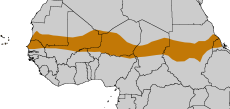Farming: A Climate Change Culprit
Simulations run at NERSC show impact of land-use change on African monsoon precipitation
June 7, 2014

The Sahel region is a narrow swath of semi-arid land that spans the African continent, from the Atlantic Ocean in the west to the Red Sea in the east. The low annual precipitation indicates the region is strongly reliant on the monsoon season for water supply.
Increased agricultural activity is a rain taker, not a rain maker, according to computer simulations of African monsoon precipitation run by researchers from Pacific Northwest National Laboratory, the University of California Los Angeles and the University of Texas.
Using supercomputers at the Department of Energy’s National Energy Research Scientific Computing Center (NERSC) and Oak Ridge Leadership Computing Facility, the research team fed observed land-use change data into a climate model and found the expansion of agriculture in the African Sahel region decreases summer rainfall through its impact on monsoon rains. The simulated decrease in summer rainfall reaches 10 percent over the Sahel, a region that is already stressed by water needs for human and ecological use.
The study findings, which offer new insights into how land-use change may affect regional rainfall, were published in Climate Dynamics.
A monsoon is more than rain, involving changes in wind, atmospheric pressure and precipitation. It is sensitive to the seasonal balance of heat from nearby oceans and heat given off from the land. Many dry regions of the world rely on annual rainfall from monsoons for the success of crops, energy production and sustainable living for humans and animals. Small changes in monsoons can have a large impact on these conditions by prolonging droughts or fostering floods. Monsoons also affect the global circulation thus spreading their influence worldwide.
For this study, which was designed to show the land use, precipitation and climate connections and provide insight for global land and water management and future climate change, the research team examined the range of model simulation responses of the African Monsoon system and Sahel precipitation due to land-use and land-cover change.
Using satellite measurements of land cover and estimates of land-cover change based on historical data, they designed their experiments to use the Weather Research and Forecasting model (WRF) and ran 16 simulations with different combinations of land surface and cloud models, representing key processes linking land use/land cover to regional climate. They further explored the relationship between the model responses to land-use/land-cover change and the monsoon conditions resulting from rainfall and surface moisture in the control simulations. The findings show a detrimental impact on the amount of summer rainfall via the effects on the African monsoon circulation.
“In general, land surface degradation reduces surface evaporation in favor of surface sensible heating and increases surface temperature,” the researchers wrote. “The resulting increase in meridional surface temperature gradient across the Sahel enhances the African Easterly Jet, which transports more moisture out of the Sahel region and reduces precipitation.”
However, the results were sensitive to the land surface model used. Simulations that had a dry and wet bias in surface moisture showed a relatively weak response, due to moisture and energy limits respectively. On the other hand, simulations with realistic climatology compared to observations showed up to a 10 percent decrease in summer rainfall over the region.
The extent and type of land-use change also has measurable effects on the climate, the researchers found. Africa's Sahel region heavily depends on monsoon rainfall to sustain crops, provide fresh water and keep the land stable. Growth like that seen in the Sahel, where the population is doubling every 20 years, can provide valuable information on how land use and climate interconnect.
The study highlights the need for more extensive measurements of surface energy fluxes to evaluate models and provide accurate projections of the effects of land-use and land changes on rainfall, the authors noted. They are now investigating how climate change, in addition to land-use change, may influence precipitation and water cycle extremes such as floods and droughts.
This article was adapted from materials provided by Pacific Northwest National Laboratory.
About NERSC and Berkeley Lab
The National Energy Research Scientific Computing Center (NERSC) is a U.S. Department of Energy Office of Science User Facility that serves as the primary high performance computing center for scientific research sponsored by the Office of Science. Located at Lawrence Berkeley National Laboratory, NERSC serves almost 10,000 scientists at national laboratories and universities researching a wide range of problems in climate, fusion energy, materials science, physics, chemistry, computational biology, and other disciplines. Berkeley Lab is a DOE national laboratory located in Berkeley, California. It conducts unclassified scientific research and is managed by the University of California for the U.S. Department of Energy. »Learn more about computing sciences at Berkeley Lab.







